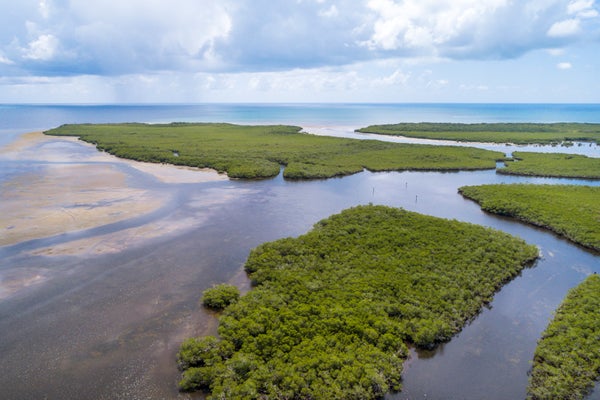Climate scientists and marine advocates are calling on governments worldwide to look beyond green policymaking when it comes to climate change. They say a critical shade is missing in the fight against global warming.
Blue.
Countries must recognize the important role that oceans have in limiting climate change and enact policies to protect marine ecosystems, the U.K.-based Environmental Justice Foundation said yesterday in a report endorsed by environmental experts and advocates.
On supporting science journalism
If you're enjoying this article, consider supporting our award-winning journalism by subscribing. By purchasing a subscription you are helping to ensure the future of impactful stories about the discoveries and ideas shaping our world today.
More than half of the world’s biological carbon is captured by animals and plants living in or around the oceans, but this so-called blue carbon and its associated ecosystems are mostly neglected in climate policy, says a letter accompanying the report.
The report highlights studies showing that mangrove forests store up to four times more carbon per hectare than tropical rainforests. Seagrass meadows store nearly 20 gigatonnes of carbon worldwide. According to Conservation International, up to 10 times more carbon is stored in coastal habitats than in tropical forests.
That means the oceans could soak up large quantities of atmospheric carbon if their ecosystems are restored and protected, the report says. Up to 200 million metric tons of CO2 could be captured annually by blue carbon sinks like mangroves, seagrasses, salt marshes and kelp forests, according to the report.
“Our coastal ecosystems are champions at removing carbon dioxide from the atmosphere and storing it in soils,” said Patrick Megonigal, who studies how coastal marshes and forests respond to climate change at George Mason University and is a signatory of the letter.
Even marine wildlife like great whales capture and store carbon in their bodies over their lifetimes.
Yet those ecosystems and the creatures they support are threatened by rising water temperatures, acidification, overfishing and commercial shipping, the report says.
Seagrass is estimated to release nearly 300 million tons of carbon each year based on rates of lost ecosystems. That figure is higher for coastal wetlands and mangroves, which account for up to 10% of all greenhouse gas emissions from deforestation, despite comprising less than 1% of tropical forest area, according to a study in Nature Geoscience.
“Unfettered human activities are turning these incredible carbon sinks into sources of greenhouse gas emissions,” Isabella Shraiman, a climate campaigner and lead author of the Environmental Justice Foundation report, said in an email.
They don’t need to be, she argues.
“Blue carbon solutions can be a low-hanging fruit within an ambitious climate mitigation policy portfolio and address the triple emergency of the climate crisis, biodiversity collapse, and human rights,” she said.
The letter urges leaders to set targets for protecting and restoring marine ecosystems as part of their commitments under the Paris Agreement. It also calls for a moratorium on deep-sea mining, and for expanding marine-protected areas to cover at least 30% of the world’s oceans and seas by 2030. Currently, less than 8% of ocean area is protected.
Marine-protected areas also lack the resources and enforcement authority for effective conservation. The same goes for national and international conventions governing ocean management and protection, the report states.
The report and letter point to a blueprint for ocean protection aimed at meeting the 30% target.
Many of those measures can help reduce carbon emissions and protect communities from the impacts of climate change. Blue-carbon ecosystems, for example, can help protect coasts from rising seas and severe storms, or provide habitats for fisheries while also acting as carbon sinks, experts say.
“The ocean has not played prominently until very recently in the climate mitigation space,” Jane Lubchenco, a marine ecologist and adviser to the Biden administration’s Office of Science and Technology Policy, said ahead of the White House climate summit in April. “Now the science is really leading the way and telling us that there is a phenomenal opportunity for the ocean to provide additional ways for us to mitigate climate that simply weren’t on our radar screen before.”
Organizers of yesterday's report make the case that marine protection is not a substitute for aggressive decarbonization.
“There has been a tendency for policymakers to silo environmental action: conservation policy is formulated separately from decarbonization policy, to the detriment of both,” said Shraiman, the lead author. “What we need now is ambitious, holistic and joined up action.”
Reprinted from E&E News with permission from POLITICO, LLC. Copyright 2021. E&E News provides essential news for energy and environment professionals.
